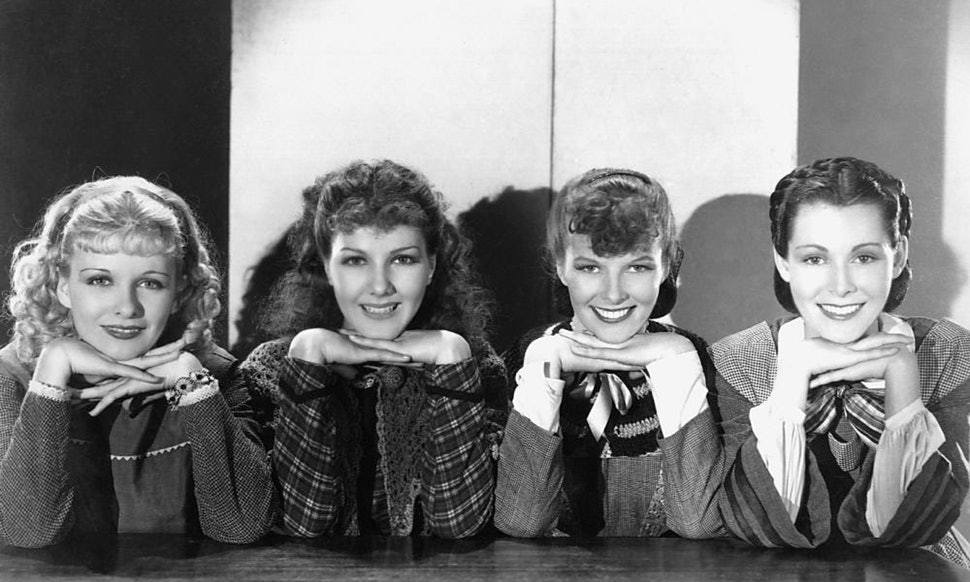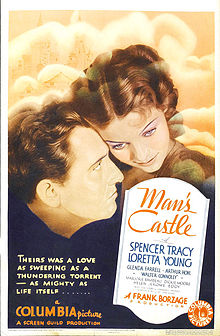 Spencer Tracy falls easily into the role of an Irish cop on the beat, Danny Dolan, working in the heart of the pier on the Lower East Side. What stands out immediately is his humanity and good-natured benevolence extended to his neighbors. In a matter of minutes, he’s nabbed himself a banana, rescued a dog, and drummed up a bit of small talk with a pretty cashier (Joan Bennett).
Spencer Tracy falls easily into the role of an Irish cop on the beat, Danny Dolan, working in the heart of the pier on the Lower East Side. What stands out immediately is his humanity and good-natured benevolence extended to his neighbors. In a matter of minutes, he’s nabbed himself a banana, rescued a dog, and drummed up a bit of small talk with a pretty cashier (Joan Bennett).
The film itself provides a fairly simple framework. Director Raoul Walsh finds himself sculpting a world out of characterizations and vignettes, not unlike future endeavors like Strawberry Blonde or Gentleman Jim. But it showcases precisely how a couple of weeks of shooting can translate into an enjoyable piece of work.
Dolan falls into company with a detective named Al (Adrian Morris) hanging around the docks and watching out for a big-time gangster named Duke Castanega. However, before they can roll out the welcome wagon, they get accosted and thoroughly distracted by the most persistent drunks in film history (Will Stanton). He’s in a perpetual state of belligerent inebriation only made funnier by the fact he’s probably the scrawniest character in the whole picture.
One of the other scenes bursting with life comes in the wake of the marriage of Kate Riley with her sister Helen (Bennett) by her side. Soon the minister has summed up the proceedings and every man looks to get a smooch from the bride before her nebbish husband can get in edgewise.
Soon the after-party is flowing with beer, belches, drumsticks, and boisterous conversation. Walsh pulls out a trick he would use later in Gentleman Jim where his characters speak to the camera. Actually, they speak over and past it and what it does is intuitive, bringing us into the fold of the movie. So right in this moment, we as an audience are there at the wedding experiencing the frenzy with everyone else.
The chemistry sparks early between Tracy and Bennett, and it slowly grows into a mutual appreciation. He does her a good deed at her sister’s wedding, turning a blind eye and earning points with her blustering father. Later, Danny and Helen trade advice: He straightens his new bowler and she stops chewing gum.
One of their lighter moments on the beat involves the aforementioned drunk in yet another altercation. This time they must defuse a confrontation involving a man who was slapped in the face with a fish. It doesn’t fall into the realm of high-brow comedy, but that doesn’t mean it can’t be delightful.
For Me and My Gal — like many films from bygone eras — also has standalone details we can look at from our current station in history and truly appreciate. A radio salesman pulls out all the tricks to get the Rileys to bite on his best merchandise. The budding couple eat vanilla ice cream together in the kitchen, and a cup of java is two bits.
Even better is the linguistic education. Sporting the new bowler, one asks the other “Well, how do I look?” They say “Jake” with a playful flick of the brim and a superlative adjective is born. Likewise, the weighty insult getting hurled around on all sides is “beezock.” Look it up.
In fact, nothing’s sacred. They take a few minutes to razz a contemporary moving picture where they say one thing out loud, and then a minute later express what they really think. The way they amuse themselves with this gag feels like unusual territory for the era as we hear their inner thoughts playing against their spoken words (in a prodding nod to the movie Strange Interlude).
As he tugs her down and she plops on the couch next to him, they are such a wonderful portrait of romance so perfectly in sync. In these self-reflexive sequences, I couldn’t help but find my mind drifting to Joan Bennett and Spencer Tracy. They both had long and illustrious careers, and almost 20 years later they would play opposite one another in a starkly different picture: Father of the Bride.
For now, they are young and in love. Bursting with all sorts of sass and equally romantic elan. Take the scene later on when he charges into her hash house aiming to marry her, and she’s clattering around behind the counter giving him her glib repartee. It’s the way romance is supposed to play out and around all the cliché beats of wanted gangsters and what-have-you, these are the other elements of the movie that feel singular and almost transcendent.
These are the little “pieces of time” Jimmy Stewart said actors can give an audience. When they reach over the counter to kiss, the embrace sends both their feet shooting up in the air like a pair of cinderellas. Tracy’s a terribly genial chap, but he works all the better with an able sparring partner. Bennett has a whipsmart, blistering independence about her, and she’s also constantly at the defense of her cowering sister.
Kate’s one weakness is the man she’s trying to forget, an escaped gangster named Duke (Walsh’s brother George). We know where the picture is going after a prison escape, the sheltering of a fugitive in an attic, and a brazen bank robbery. Only one logical resolution remains. There’s the obligatory confrontation and Tracy becomes a hero. Why dwell on any of this? We’ve seen it umpteen times before (and after).
Walsh seems to have a great deal more fun in the final minutes. Now there is a second wedding in process, and it’s yet another excuse for mayhem. We sit there trying to take it all in as Tracy and Bennett get whisked around, swamped by people, trading kisses. How lovely it is to be a part of this contingent living vicariously off their energy.
Spencer Tracy always makes the toils of an actor feel effortless and Bennett does a swell job to counter him. People don’t talk much about their onscreen partnership, but it’s pleasantly appealing. In the back of our minds, we know with content in our hearts Me and My Gal was just the beginning. More people should seek it out.
3.5/5 Stars


















 “Blessed are the poor in spirit for their’s is the kingdom of heaven”
“Blessed are the poor in spirit for their’s is the kingdom of heaven” You could say that Fritz Lang was fascinated, even preoccupied with issues of justice. M, Fury, and You Only Live Once all take a particular interest in crime in relation to systems of justice while still functioning as tense thrillers. Although Fury was his first film across the pond in Hollywood, Lang maintained his fine form in a potent debut.
You could say that Fritz Lang was fascinated, even preoccupied with issues of justice. M, Fury, and You Only Live Once all take a particular interest in crime in relation to systems of justice while still functioning as tense thrillers. Although Fury was his first film across the pond in Hollywood, Lang maintained his fine form in a potent debut. I’ve seen both versions of Father of the Bride and Steve Martin is fine and dandy but there is no better lovable curmudgeon than Spencer Tracy and he dons the role of the protective and skeptical father so effortlessly.
I’ve seen both versions of Father of the Bride and Steve Martin is fine and dandy but there is no better lovable curmudgeon than Spencer Tracy and he dons the role of the protective and skeptical father so effortlessly.